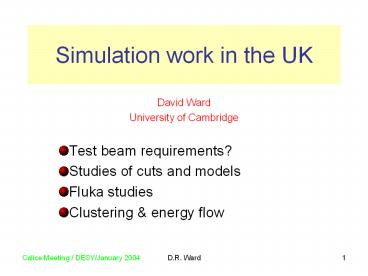David Ward
Title: David Ward
1
Simulation work in the UK
- David Ward
- University of Cambridge
- Test beam requirements?
- Studies of cuts and models
- Fluka studies
- Clustering energy flow
2
Test beam requirements?
5 GeV p
- Use MC studies to indicate what data would be
most useful in validating MC models. - Compare samples of 104 5 GeV p in Geant3
(histo) and Geant4 (points) - Prototype geometry scintillator Hcal model
- Significant differences seen at the level of 104
events, especially in the Hcal
3
Differences vary with energy
1 GeV p
50 GeV p
At 5 GeV energy in ECAL was about OK, but G4
higher (lower) at 1 (50) GeV
4
Protons are different from p
5 GeV p
5 GeV p
i.e. models disagree differently for protons and
pions.
5
Antiprotons are different again
5 GeV p
5 GeV pbar
6
Neutrons similar to protons?
5 GeV p
5 GeV n
Discrepancies between models look similar for p
and n
7
Compare RPC/scintillator HCAL (p 5 GeV)
Scintillator
RPC
Difference in transverse HCAL distribution much
smaller for RPC.
8
Conclusions re. test beam
- 1 precision suggests gt104 events per particle
type and energy. - Try to range from 1-80 GeV (10-15 energy
points?). - Pions and protons desirable (?Cerenkov needed).
Also electrons ( muons?) for calibration. - Both RPC and Scintillator HCAL needed.
- Position scan use beam width (a few cm at
FNAL-MTBF). Need MWPCs etc for position
determination. But would need more statistics if
splitting up data. Aim for 106 events/energy
point? - Also some data at 30-45o incidence.
9
Study of hadronic models (G Mavromanolakis)
- Studied p, p- at 1 GeV and 10 GeV (104 event
samples) - Geant3 with Gheisha
- Geant3 / Gheisha (SLAC version)
- Geant3 / Fluka
- Geant3 / Fluka / Micap (used for n lt 20 MeV)
- Geant4 / Mokka / LHEP
- Prototype geometry
- Geant 3 energy cutoffs 10 keV (e/m) and 100 keV
(had) - Geant 4 range cut 5mm
- Threshold ½ mip/cell
- Study response, transverse and longitudinal
shower shape. - Plots normalised to unit area
10
Study of tracking cutoffs(G Mavromanolakis)
Geant4/Mokka quite insensitive to cutoffs.
Default (5mm) looks fine. Geant3 is rather
sensitive to cuts. 10 keV looks reasonable for
electromagnetics probably around 100 keV is OK
for hadronics.
11
Response
Scintillator HCAL Large differences between
models, especially in the Hcal. n.b. FLUKA/Micap
only differs from Fluka-GH in the low energy
neutrons
12
Shower profiles
Differences in longitudinal profile for Fluka
models Transverse distribution in Hcal narrower
for Micap Both these effects slightly more
pronounced at 1 GeV
13
Compare Gheisha versions
Differences between Geant3 and Geant4, as
before. SLAC version of G3/Gheisha mainly
affects HCAL response.
14
FLUKA studies (N Watson)
- Geant3-Fluka is a deprecated version.
- Current version of Fluka particularly interesting
for hadronic interactions - Wish to
- Test new Mokka detector models
- Investigate full TDR type geometry prototypes
- Avoid coding each geometry directly in Fluka
- error prone, may introduce non-physics
differences - Chosen to use FLUGG package (P.Sala et al) From
ATL-SOFT-98-039 - Geometry physics decoupled in G4 and Fluka
- Wrappers for f77/C
15
FLUKA current status
- Mokka running within flugg/Fluka framework
- Using Mokka-01-05 Geant4.5.0.p01 clhep1.8.0
gcc3.2 - Flugg05 (Jan. 2003)
- Fluka 2002.4 (May 2003)
- Procedure start from Mokka release and delete
- all classes except for detector construction,
detector parametrisation, magnetic field
construction - corresponding include, variable, class
definitions in .cc/.hh - anything related to G4RunManager,
DetectorMessenger - code where SensitiveDetector is set
- interactive code, visualisation, etc.
- Validation
- Minimal debugging tools in flugg, e.g. P55
prototype geometry - Library/compiler consistency (fluka object-only
code) - Using ProtEcalHcalRPC model, works
16
Compare FLUKA/FLUGG with Geant3/4
5 GeV p
5 GeV p
FLUKA
G3/G4 Gheisha
17
Fluka ongoing work
- Restrict study to energy deposited in active
layers - Improve reliability for larger samples
- understood technical issue
- Review energy thresholds/step size in Fluka
- default min. K.E. gt 100 keV
- neutrons, 19.6 MeV
- energy e/g gt 500 keV (??)
- low energy neutron cross-sections
- Compare systematically with G3/G4 results,
- Same initial conditions
- Thresholds, mip normalisation, etc.
- Adopt same output format as DRW/GM. Maybe go to
LCIO? - Integration with Mokka geometry classes
- Need to feed changes back to Mokka developers
18
Clustering energy flow (C. Ainsley)
- Aim to produce a flexible algorithm, not tied
to specific geometry/MC program. - Use to test sensitivity to different features of
MC showering models. - Currently testing using Mokka with TDR geometry,
1x1 cm2 cell sizes in both ECAL/HCAL. - Single barrel stave.
- Started using Root input files now converting to
LCIO. - Easier to compare with REPLIC and SNARK(Brahms)
now LCIO is available.
19
Algorithm in outline
- Algorithm mixes tracking and clustering aspects.
- Sum hits within cell apply threshold of ? MIP.
- Form clusters in layer 1 of ECAL.
- Associate each hit in layer 2 with nearest hit in
layer 1 within cone of angle a. If none,
initiate new cluster. - Track onwards layer by layer through ECAL and
HCAL, looking back up to 2 layers to find nearest
neighbour, if any.
20
Reconstruction of single particles
15 GeV e-
15 GeV p-
Each cluster has a different colour black is
highest energy one.
21
Multiparticle events (t, h?)
15 GeV h?
15 GeV t-
Looking quite encouraging.
22
Summary
- Continuing comparisons between MC models
focussing now on prototype setups. - Just starting systematic study of various Geant4
hadronic packages. - ? useful input for defining test beam strategy.
- Work on Fluka progressing.
- Started work on clustering/energy flow.
- Work on MC starting at IC (D.Bowerman, C.Fry)
feed info from DAQ commissioning into realistic
digitization simulation of MC.































